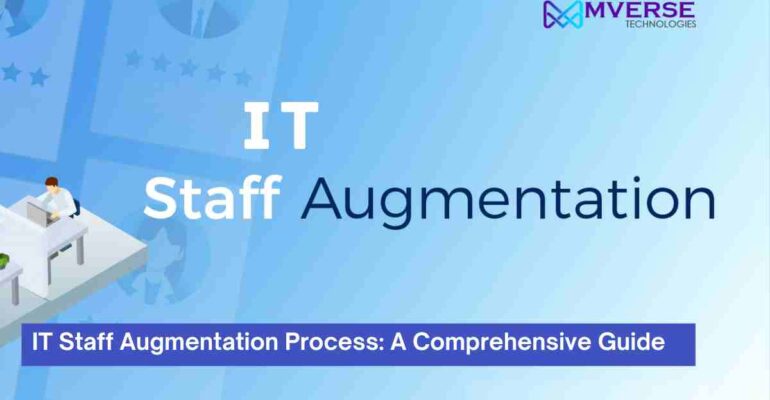IT Staff Augmentation Process: A Comprehensive Guide

IT Staff Augmentation Process: A Comprehensive Guide
As businesses grow and evolve, they often face the challenge of scaling their IT departments to meet the changing demands of their organization. One solution to this challenge is IT staff augmentation, which allows businesses to supplement their existing IT teams with external resources. This approach can help organizations quickly and cost-effectively access specialized skills and expertise while maintaining control over the work and the team.

IT staff augmentation is a process that involves identifying the skills and expertise needed to meet specific project requirements and then finding and hiring the right external resources to fill those gaps.
The process typically involves several steps, including defining project requirements, identifying the skills and expertise needed, selecting the right external resources, and managing the work and the team. Best practices in IT staff augmentation include developing clear project requirements, conducting thorough due diligence on potential external resources, and establishing effective communication and collaboration processes.
Key Takeaways
- IT staff augmentation is a process that allows businesses to supplement their existing IT teams with external resources to meet specific project requirements.
- The IT staff augmentation process typically involves several steps, including defining project requirements, identifying the skills and expertise needed, selecting the right external resources, and managing the work and the team.
- Best practices in IT staff augmentation include developing clear project requirements, conducting thorough due diligence on potential external resources, and establishing effective communication and collaboration processes.
Understanding IT Staff Augmentation

As an experienced IT professional, I have come across various staffing models that organizations use to fulfill their IT needs. One of these models is IT staff augmentation. IT staff augmentation is a process where an organization hires external IT professionals to work with their in-house team on a project basis or for a specific duration.
Benefits of IT Staff Augmentation
IT staff augmentation offers several benefits to organizations. Firstly, it provides flexibility in hiring IT professionals. Organizations can hire IT staff for a specific duration or project, which helps them avoid the cost of hiring a full-time employee. Secondly, IT staff augmentation provides access to a diverse pool of IT talent, which can help organizations find the right talent for their specific project needs. Thirdly, IT staff augmentation can help organizations reduce the time and cost of training new employees.
IT Staff Augmentation vs. Traditional Hiring
IT staff augmentation differs from traditional hiring in several ways. Firstly, IT staff augmentation provides access to a diverse pool of IT talent, which can help organizations find the right talent for their specific project needs. In contrast, traditional hiring involves hiring a full-time employee who may not have the specific skills needed for a project. Secondly, IT staff augmentation provides flexibility in hiring IT professionals. Organizations can hire IT staff for a specific duration or project, which helps them avoid the cost of hiring a full-time employee. In contrast, traditional hiring involves hiring a full-time employee who may not be needed after the project is completed. Finally, IT staff augmentation can help organizations reduce the time and cost of training new employees. In contrast, traditional hiring involves the cost of training new employees, which can be time-consuming and expensive.
In conclusion, IT staff augmentation is a staffing model that offers several benefits to organizations. It provides flexibility in hiring IT professionals, and access to a diverse pool of IT talent, and can help organizations reduce the time and cost of training new employees.
The IT Staff Augmentation Process
As an IT manager, I understand the importance of having the right team to achieve project success. However, there are times when the existing team may not have the required skills or expertise to complete a project. In such cases, IT staff augmentation can be an effective solution to bridge the gap. Here is a brief overview of the IT staff augmentation process.
Identifying the Need for Augmentation
The first step in the IT staff augmentation process is identifying the need for augmentation. This could be due to a variety of reasons, such as a shortage of resources, a lack of required skills, or a sudden surge in demand. Once the need for augmentation is identified, it is important to evaluate the impact of the augmentation on the project timeline, budget, and overall project success.
Selection of the Right Augmentation Partner
The next step is to select the right IT staff augmentation partner. This involves evaluating potential partners based on their experience, expertise, and ability to provide the required skills. It is important to select an augmentation partner who has a proven track record of delivering quality work and has experience working in similar projects. This ensures that the augmented staff can seamlessly integrate into the existing team and contribute to project success.
Onboarding Augmented Staff
Once the right augmentation partner is selected, the next step is to onboard the augmented staff. This involves providing them with the necessary resources, such as access to tools, systems, and documentation. It is important to ensure that the augmented staff is trained on the project requirements, processes, and standards to ensure that they can deliver quality work.
Integration into Existing Teams
The final step in the IT staff augmentation process is integrating the augmented staff into the existing team. This involves assigning tasks and responsibilities, monitoring progress, and providing feedback. It is important to ensure that the augmented staff is aligned with the project goals, timelines, and quality standards. Effective communication and collaboration are key to ensuring the success of the augmented staff.
In conclusion, the IT staff augmentation process involves identifying the need for augmentation, selecting the right partner, onboarding the augmented staff, and integrating them into the existing team. By following these steps, IT managers can effectively leverage IT staff augmentation to achieve project success.
Best Practices in IT Staff Augmentation
As an IT professional with extensive experience in software development staff augmentation, I have found that there are several best practices that can help ensure the success of an IT staff augmentation project. In this section, I will discuss some of the most important best practices that I have found to be effective.
Clear Communication Channels
Clear communication channels are essential for the success of any IT staff augmentation project. It is important to establish clear lines of communication between the client and the staff augmentation team from the outset of the project. This includes establishing a clear reporting structure, setting expectations for communication frequency, and ensuring that all parties have access to the necessary tools and resources to communicate effectively.
Regular Performance Reviews
Regular performance reviews are critical to the success of an IT staff augmentation project. It is important to establish a performance review process that includes regular check-ins with the staff augmentation team to ensure that they are meeting the client’s expectations and that any issues are addressed in a timely manner. This can include regular meetings, performance metrics, and feedback mechanisms to ensure that the team is meeting the client’s needs.
Cultural Fit and Team Dynamics
Cultural fit and team dynamics are also critical to the success of an IT staff augmentation project. It is important to ensure that the staff augmentation team is a good fit for the client’s culture and that they are able to work effectively with the client’s existing team. This can include conducting cultural assessments, team-building exercises, and other activities to ensure that the team is able to work effectively together.
Overall, these best practices can help ensure the success of an IT staff augmentation project. By establishing clear communication channels, conducting regular performance reviews, and ensuring a good cultural fit and team dynamics, IT staff augmentation projects can be completed successfully and efficiently.
Challenges and Solutions in IT Staff Augmentation
As a provider of IT staff augmentation services, I understand the challenges that come with the process. In this section, I will discuss some of the common challenges that organizations face during IT staff augmentation and provide some solutions to overcome them.
Managing Remote Teams
One of the biggest challenges in IT staff augmentation is managing remote teams. When working with remote teams, communication and collaboration can become difficult due to differences in time zones, cultural differences, and language barriers. To overcome this challenge, it is important to establish clear communication channels, set expectations, and provide regular feedback to the team.
To ensure effective communication, we use project management tools such as Trello and Asana that allow us to track progress, assign tasks, and communicate with the team in real time. We also use video conferencing tools like Zoom and Skype to hold regular meetings and discuss any issues that arise.
Ensuring Security and Confidentiality
Another challenge in IT staff augmentation is ensuring the security and confidentiality of sensitive information. When working with remote teams, it can be difficult to control access to sensitive data and ensure that it is not being shared with unauthorized parties.
To overcome this challenge, we implement strict security measures, such as two-factor authentication, data encryption, and access controls. We also ensure that all team members sign non-disclosure agreements and undergo security training to understand the importance of data confidentiality.
Navigating Legal and Compliance Issues
Navigating legal and compliance issues can also be a challenge in IT staff augmentation. When working with remote teams, it is important to ensure that all team members comply with local laws and regulations.
To overcome this challenge, we work closely with our clients to understand their legal and compliance requirements. We also ensure that all team members comply with local laws and regulations by conducting background checks and verifying their credentials.
In conclusion, IT staff augmentation can be a complex process that requires careful planning and execution. By understanding the challenges and implementing the solutions discussed in this section, organizations can successfully navigate the process and achieve their business objectives.
Evaluating IT Staff Augmentation Success

As with any business process, it is essential to evaluate the success of IT staff augmentation. This evaluation helps businesses understand the effectiveness of their IT staff augmentation efforts and identify areas for improvement. In this section, I will discuss some key performance indicators (KPIs), feedback loops, continuous improvement, strategic alignment, and business impact that can help evaluate IT staff augmentation success.
Key Performance Indicators (KPIs)
KPIs are essential metrics that help evaluate the success of IT staff augmentation. These metrics can include the number of new hires, the time to fill a position, the cost per hire, the retention rate, and the satisfaction rate of both the client and the augmented staff. By tracking these KPIs, businesses can identify areas for improvement and measure the effectiveness of their IT staff augmentation efforts.
Feedback Loops and Continuous Improvement
Feedback loops are crucial for evaluating the success of IT staff augmentation. By gathering feedback from both the client and the augmented staff, businesses can identify areas for improvement and make necessary changes. Continuous improvement is also essential in IT staff augmentation. By continuously improving the process, businesses can ensure that they are providing the best possible service to their clients.
Strategic Alignment and Business Impact
Strategic alignment and business impact are also important factors in evaluating the success of IT staff augmentation. Strategic alignment ensures that the IT staff augmentation process is in line with the business’s overall strategy. Business impact measures the effectiveness of IT staff augmentation in achieving the business’s goals. By aligning the IT staff augmentation process with the business’s strategy and measuring its impact, businesses can ensure that they are getting the most out of their IT staff augmentation efforts.
In conclusion, evaluating the success of IT staff augmentation is crucial for businesses to identify areas for improvement and measure the effectiveness of their efforts. By tracking KPIs, gathering feedback, continuously improving the process, and aligning it with the business’s strategy, businesses can ensure that they are providing the best possible service to their clients.
Frequently Asked Questions

What are the key differences between staff augmentation and traditional staffing solutions?
Traditional staffing solutions involve hiring full-time employees to work on a project or within a company. Staff augmentation, on the other hand, involves hiring temporary staff to supplement an existing team or to provide expertise in a particular area. One of the key differences is that with staff augmentation, the company retains control over the project while having access to specialized talent.
How does the staff augmentation model integrate with existing company processes?
Staff augmentation is designed to integrate seamlessly with existing company processes. The staff augmentation provider will work closely with the company to understand its needs and requirements, and then provide personnel who are a good match for the project. These personnel are often highly skilled and experienced and can help to improve the overall efficiency of the project.
What are the advantages of choosing staff augmentation over hiring contractors?
One of the main advantages of staff augmentation is that it provides access to a wider pool of talent. This means that companies can find the right person for the job, regardless of their location or experience. Additionally, staff augmentation is often more cost-effective than hiring contractors, as the company does not need to pay for benefits or overhead costs.
What are the long-term implications of staff augmentation for a company’s workforce strategy?
Staff augmentation can have long-term implications for a company’s workforce strategy. By using staff augmentation, a company can access specialized talent without having to commit to hiring full-time employees. This can help to reduce costs and improve flexibility, while also allowing the company to adapt to changing market conditions.
How do companies ensure the quality of personnel provided through staff augmentation?
Companies can ensure the quality of personnel provided through staff augmentation by working closely with the staff augmentation provider. The provider should have a rigorous screening process to ensure that all personnel are highly skilled and experienced. Additionally, the company should provide clear guidelines and expectations for the project and should monitor the progress of the team to ensure that the project is on track.
